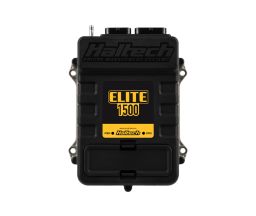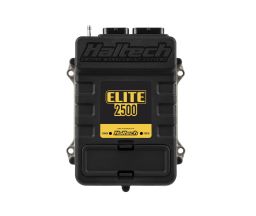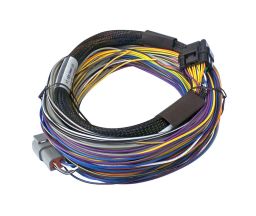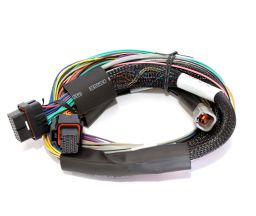Haltech ECU Buyer’s Guide – Which Haltech ECU Is Right for Your Build?
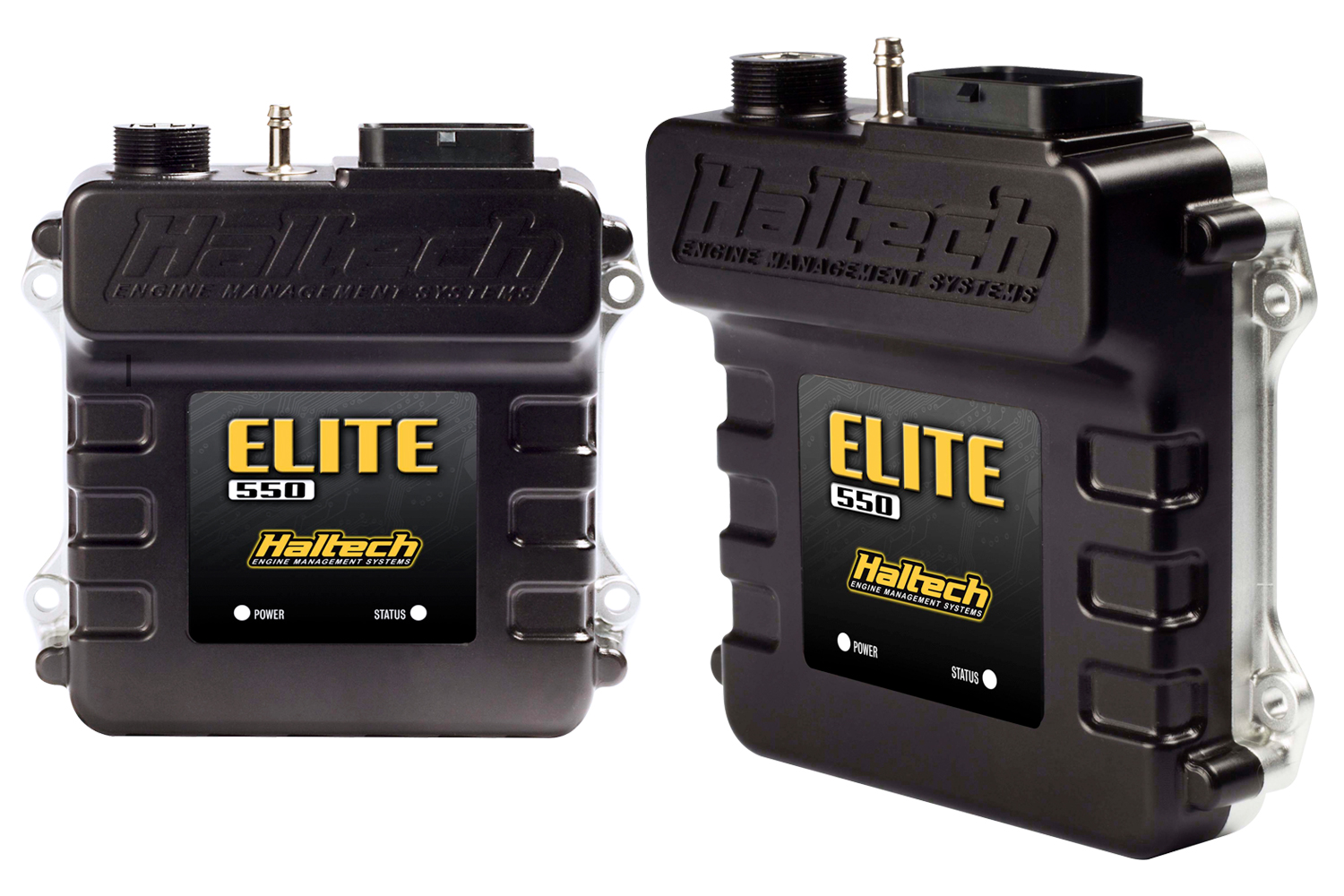
Haltech ECU Buyer’s Guide – Which Haltech ECU Is Right for Your Build?
Choosing the right Haltech ECU can feel overwhelming – especially with options like the Elite 550, Elite 750, Elite 1500, Elite 2500/T, Nexus S2, Nexus S3, Nexus R3 and Nexus R5 on the table. This buyer’s guide breaks it down in plain language so you can match the right ECU (or VCU) to your engine, wiring and performance goals.
Whether you’re wiring a dedicated race car from scratch, doing an engine swap, or upgrading a street car with flex fuel and boost control, the key is to:
- Know your wiring – factory loom or fresh wiring?
- Know your engine – how many cylinders and which features?
- Know your goals – street, track, drag or time attack?
1. Know Your Wiring – Plug’n’Play vs Universal ECUs
Haltech splits its ECUs into two main groups: Plug’n’Play ECUs and Universal ECUs. Start by deciding what you’re doing with the wiring.
Plug’n’Play ECUs – When You’re Keeping the Factory Harness
If you want to retain the factory wiring harness, a Haltech Plug’n’Play solution is usually the easiest path. These are designed to plug straight into your OEM loom with minimal fuss:
- Platinum Pro Plug-in ECUs – connect directly to the factory harness.
- Elite Plug’n’Play ECUs – use a Haltech Plug’n’Play adaptor harness to connect an Elite ECU to the factory loom.
Benefits of Plug’n’Play:
- Minimal wiring changes.
- Quicker install and easier troubleshooting.
- Perfect for mild-to-serious street and track builds that don’t need a complete rewire.
Universal ECUs – When You’re Rewiring or Building from Scratch
If you’re:
- Rewiring a car completely,
- Doing an engine swap, or
- Building a race car from a bare shell,
then Universal Haltech ECUs (Elite and Nexus) are the way to go. These work with almost any engine type and configuration and are supported by:
- Universal wiring harnesses
- Engine-specific terminated harnesses
The latest Haltech Nexus Series VCUs go even further by combining:
- Engine management
- Data logging
- Power distribution (on-board PDM)
This makes wiring cleaner, faster and safer – especially for complex race cars with lots of accessories, pumps, fans and solenoids.
2. Know Your Engine – Cylinder Count, Sensors and Control
Your engine configuration and the features you want will narrow down which Haltech ECU you should choose. The main things to think about are:
- How many cylinders?
- How many injectors and coils?
- Which sensors and advanced functions do you need?
Inputs & Outputs – Why They Matter
Different ECUs provide different numbers of:
- Injection outputs – how many injectors you can control individually.
- Ignition outputs – to run individual coils or wasted-spark setups.
- Digital pulsed outputs (DPO) and half-bridge outputs (HBO) – for driving solenoids, valves, boost control, DBW, etc.
- Analog voltage inputs (AVI) – for extra sensors (fuel pressure, oil pressure, flex fuel, etc.).
- Knock inputs – single or dual knock control.
As a rule of thumb:
- Elite 550 / Elite 750 – suited to simpler 4- and some 6-cylinder engines without lots of extra devices.
- Elite 1500 / Elite 2500/T – designed for more complex 4, 6 and V8 engines with advanced control needs.
- Nexus S2 / S3 / R3 / R5 – handle high-end builds, big horsepower and lots of sensors, drive-by-wire throttles and race functions.
Key Engine Features to Consider
When choosing a Haltech ECU, list out the features your engine needs now – and what you might want in future:
- Drive-by-wire throttle (DBW)
- Flex fuel control (E85 / pump fuel blend)
- Closed-loop O2 control (all Elite and Nexus ECUs support dual closed-loop O2)
- Knock control – single or dual channel
- Variable cam control (VVT) – up to 4 cams on Elite 1500, 2500 and all Nexus VCUs
- Long term learning – up to 3D on Elite 550/750 and 4D on the rest
If your engine has DBW, multiple VVT cams, knock sensors and flex fuel, you’ll quickly find yourself in Elite 1500 / Elite 2500/T or Nexus territory.
3. Know Your Goals – Street Car, Track Car or Full Race Program?
The same engine can be managed by different ECUs depending on how serious your build is. Think about:
- Is this a street car with occasional track days?
- A dedicated track or time-attack car?
- A drag racing car chasing consistency and big power?
Haltech ECUs include a wide range of race functions:
- Launch control – available on all listed ECUs.
- Nitrous control – up to 6 stages on Elite 1500, 2500/T and all Nexus VCUs.
- Boost control – 3D or 4D closed-loop depending on ECU.
- Anti-lag & rolling anti-lag – supported on Elite 1500, 2500/T and all Nexus VCUs.
- Flat shift (gear cut) – basic on Elite 550/750, advanced on Elite 1500/2500/T and Nexus.
- Torque management – available on Elite 2500T and all Nexus VCUs.
- Shock travel & ride height, race timer, trans brake – supported on Elite 1500/2500/T and Nexus VCUs.
If you’re building a high-end race car, particularly with an automatic transmission, multiple power adders and the need for advanced safety, logging and power distribution, a Nexus VCU (S2, S3, R3 or R5) will usually be the best long-term choice.
4. Haltech Universal ECU & VCU Overview
Below is a practical overview of the main Haltech Elite and Nexus models, based on the comparison data provided. Use this as a quick reference, then read the model summaries below for more detail.
| Model | Injection Outputs | Ignition Outputs | Drive-by-Wire | Knock Inputs | On-board Wideband | On-board PDM | Ideal Use Case |
|---|---|---|---|---|---|---|---|
| Elite 550 | 4 (peak & hold) | 4 | No | 0 | No | No | Simple 4-cyl builds & entry-level engines |
| Elite 750 | 6 (peak & hold) | 6 | No | 0 | No | No | 4–6 cyl engines needing extra I/O |
| Elite 1500 | 4 (peak & hold) | 4 | Single DBW | 1 | No | No | Advanced 4-cyl & some 6-cyl with DBW/VVT |
| Elite 2500 / 2500T | 8 (peak & hold) | 8 | Single DBW | 2 | No | No | Complex 6-cyl & V8 engines; 2500T adds torque management |
| Nexus S2 | 4 (peak & hold) | 4 | Dual DBW | 2 | 1 x NTK/LSU 4.9 | No | High-end 4-cyl / small engines with advanced features |
| Nexus S3 | 8 (peak & hold) | 8 | Dual DBW | 2 | 1 x NTK/LSU 4.9 | No | Serious 6-cyl & V8 builds |
| Nexus R3 | 8 (peak & hold) | 8 | Dual DBW | 2 | 1 x NTK/LSU 4.9 | Yes | Race-focused builds needing integrated PDM & G-sensor |
| Nexus R5 | 18 (peak & hold) | 12 | Dual DBW | 2 | 2 x NTK/LSU 4.9 | Yes | Flagship motorsport ECU/VCU for complex, high-power cars |
5. Haltech Elite ECU Range – Model Summaries
Elite 550 – Compact ECU for Simple Builds
- 4 x injection outputs, 4 x ignition outputs.
- Internal 4-bar MAP sensor.
- Single-level engine protection.
- Up to 3D long term learning, 2 MB data logging.
- No drive-by-wire, no knock control, no traction control.
Best suited to simple 4-cylinder engines where you don’t need DBW, advanced race functions or extensive sensor inputs. Great for budget-conscious street and basic track setups.
Elite 750 – More I/O, Still Affordable
- 6 x injection outputs, 6 x ignition outputs.
- Internal 4-bar MAP sensor, 2 x AVIs, 2 x digital pulsed inputs.
- Single-level engine protection, 2 MB data logging.
- No drive-by-wire, no knock control, no traction control.
Ideal for 4–6 cylinder engines that need more I/O than an Elite 550 but don’t require DBW or high-end race features.
Elite 1500 – Advanced 4-Cylinder / Medium Complexity Engines
- 4 x injection outputs, 4 x ignition outputs.
- Internal 4-bar MAP, 10 x AVIs, 4 x synchronized pulsed inputs.
- Single drive-by-wire throttle support.
- Single knock input, variable cam control for up to 4 cams.
- Traction control, anti-lag, rolling anti-lag, advanced flat shift.
- Multi-level engine protection, 8 MB data logging.
Perfect for advanced 4-cylinder turbo builds (and some 6-cylinders) that need DBW, VVT, knock control and serious race functions without stepping up to an 8-injector ECU.
Elite 2500 / Elite 2500T – For Serious 6-Cylinder & V8 Engines
- 8 x injection outputs, 8 x ignition outputs.
- Internal 4-bar MAP, 10 x AVIs, 4 x synchronized pulsed inputs.
- Single drive-by-wire support, dual knock inputs.
- Variable cam control on up to 4 cams.
- Traction control, anti-lag, rolling anti-lag, advanced flat shift, multi-level engine protection.
- 8 MB data logging.
- Elite 2500T version adds torque management (driveshaft & engine RPM targeting) for drag and high-powered automatic applications.
A go-to ECU for turbo sixes and V8s where you need full sequential control, DBW, VVT and advanced safety and race strategies.
6. Haltech Nexus VCU Range – Next-Level Integration
The Nexus S2, S3, R3 and R5 are VCUs (Vehicle Control Units) that combine:
- Engine control
- Power distribution (on-board PDM on R3 and R5)
- Data logging
- Communications and networking
All Nexus VCUs include:
- Internal 4-bar MAP sensor (R5 uses external MAP).
- Dual drive-by-wire support.
- Flex fuel, dual closed-loop O2, dual knock, up to 4-cam VVT.
- Advanced race functions – traction control, anti-lag, rolling anti-lag, advanced flat shift, torque management, race timer, shock travel & ride height, etc.
- USB-C connectivity with low power wake-up via cable, WiFi with Haltech Connect App compatibility.
- Large data logging: 128 MB on S2/S3/R3, 512 MB on R5.
- Onboard wideband: 1 x NTK/LSU 4.9 on S2, S3, R3, and 2 x NTK/LSU 4.9 on R5.
Nexus S2 – Compact VCU for High-End 4-Cylinder Builds
- 4 x injection outputs, 4 x ignition outputs.
- 11 x AVIs, 6 x synchronized pulsed inputs.
- Dual DBW, dual knock inputs.
- Onboard wideband controller (1 x NTK/LSU 4.9).
- No onboard PDM.
Ideal for high-spec 4-cylinder engines or smaller combos needing Nexus features without the full PDM integration of the R-series.
Nexus S3 – VCU for Serious 6-Cyl & V8 Builds
- 8 x injection outputs, 8 x ignition outputs.
- 11 x AVIs, 6 x synchronized pulsed inputs.
- Dual DBW, dual knock inputs, 4-cam VVT.
- Onboard wideband controller (1 x NTK/LSU 4.9).
- No onboard PDM.
Great for powerful 6-cylinder and V8 engines where you want Nexus-level control and data without integrating the PDM into the same box.
Nexus R3 – Race-Focused VCU with On-Board PDM
- 8 x injection outputs, 8 x ignition outputs.
- 11 x AVIs, 6 x synchronized pulsed inputs.
- Dual DBW, dual knock inputs, 4-cam VVT.
- Onboard wideband (1 x NTK/LSU 4.9).
- On-board PDM with high current outputs for pumps, fans, lights, etc.
- Inertia / G-sensor built in.
Designed for serious competition cars where wiring simplicity, reliability and advanced control strategies are critical.
Nexus R5 – Flagship Motorsport VCU
- 18 x injection outputs, 12 x ignition outputs.
- 23 x AVIs, 10 x synchronized pulsed inputs.
- External MAP input, dual DBW, dual knock.
- 2 x onboard wideband controllers (NTK/LSU 4.9).
- On-board PDM with multiple high-current outputs.
- Inertia / G-sensor built in.
- Huge 512 MB data logging.
This is Haltech’s top-level solution for complex, high-horsepower vehicles running multiple engines or advanced control strategies, or where you need massive I/O and logging for professional motorsport.
7. How to Choose – Quick Decision Checklist
- Keeping factory wiring? Choose a Plug’n’Play Haltech ECU (Platinum Pro or Elite with Plug’n’Play adaptor harness).
- Rewiring or building a race car? Choose a Universal Elite or Nexus ECU/VCU.
- Simple 4-cylinder, budget build? Elite 550 or Elite 750 is often enough.
- Advanced 4-cylinder turbo with DBW, VVT, knock? Look at Elite 1500 or Nexus S2.
- 6-cylinder or V8 with full sequential control and race features? Elite 2500/T or Nexus S3.
- All-out race car needing integrated PDM and logging? Nexus R3 or Nexus R5, depending on I/O requirements.
Haltech ECU Buyer’s Guide – FAQs
Which Haltech ECU should I choose for a basic turbo 4-cylinder street car?
For a basic turbo 4-cylinder with limited extras, an Elite 550 or Elite 750 is usually suitable. If you need drive-by-wire, VVT on multiple cams or advanced race functions, step up to an Elite 1500 or Nexus S2.
What’s the difference between Haltech Plug’n’Play and Universal ECUs?
Plug’n’Play ECUs are designed to plug directly into your factory harness (or via a Plug’n’Play adaptor harness), making installation quicker and simpler. Universal ECUs require more wiring but will work with almost any engine and are ideal for engine swaps, full rewires and race car builds.
Do I need a Nexus VCU, or is an Elite ECU enough?
If you’re building a street or club-level car with moderate I/O needs, an Elite ECU is often all you require. If you want integrated PDM, WiFi connectivity, huge data logging, more I/O and advanced control for a serious race car, a Nexus VCU (S2, S3, R3 or R5) is usually the better long-term choice.
Which Haltech ECUs support drive-by-wire throttles?
Drive-by-wire throttle support:
- No DBW: Elite 550, Elite 750.
- Single DBW: Elite 1500, Elite 2500/T.
- Dual DBW: Nexus S2, Nexus S3, Nexus R3, Nexus R5.
Which Haltech ECUs have onboard wideband controllers?
The Elite series does not have an onboard wideband controller – you’ll use an external wideband controller and feed its signal into the ECU. The Nexus range includes onboard wideband:
- Nexus S2, S3, R3: 1 x NTK/LSU 4.9.
- Nexus R5: 2 x NTK/LSU 4.9.
Do all Haltech ECUs support flex fuel?
Yes. Flex fuel support is available across the board – Elite 550, 750, 1500, 2500/T and all Nexus VCUs (S2, S3, R3, R5) can be configured to work with a flex fuel sensor to adjust fuel, ignition and boost based on ethanol content.
Which Haltech ECUs have traction control?
Traction control is not available on the Elite 550 and Elite 750. It is available on the Elite 1500, Elite 2500/T and all Nexus models (S2, S3, R3, R5), along with advanced race strategies like anti-lag and rolling anti-lag.
Do any Haltech ECUs include a built-in power distribution module (PDM)?
Yes. The Nexus R3 and Nexus R5 include an on-board PDM with high-current outputs, simplifying wiring for fans, pumps, lights and other loads. The Elite series and Nexus S2/S3 do not have an onboard PDM and will require a separate PDM or conventional fusing and relays.
Can Haltech ECUs talk to other devices over CAN and WiFi?
All Elite and Nexus ECUs support CAN Bus networking (1–3 CAN networks depending on the model). The Nexus range also includes WiFi with an internal or external antenna, and is compatible with the Haltech Connect App for wireless monitoring and setup.

